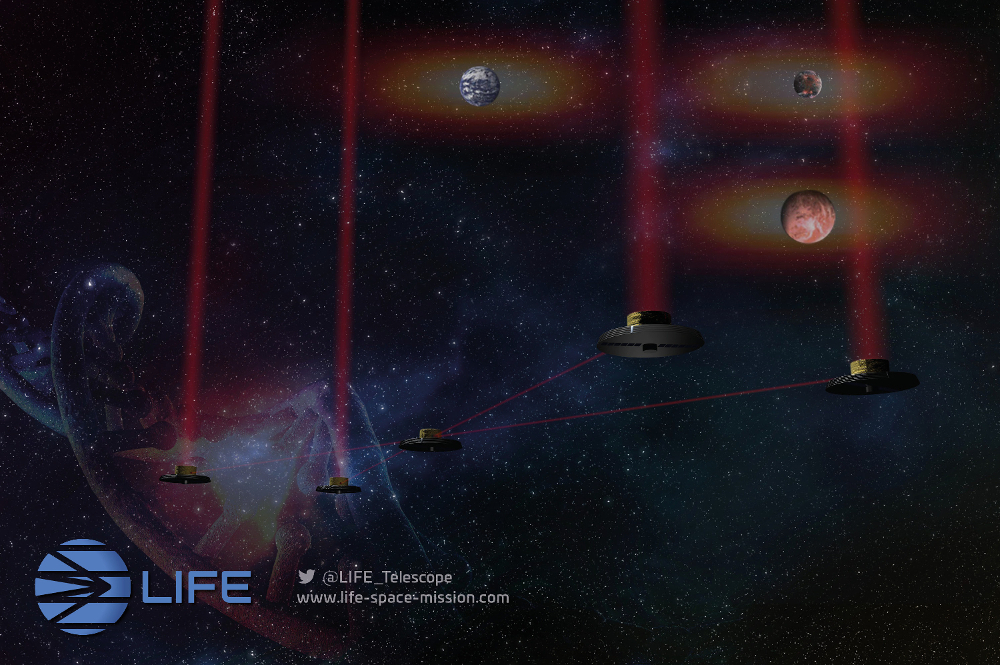The Large Interferometer For Exoplanets (LIFE) mission: status and progress report
- 1ETH Zürich, Zürich, Switzerland
- 2National Center for Competence in Research (NCCR) PlanetS, Switzerland
- *A full list of authors appears at the end of the abstract
Summary
The Large Interferometer For Exoplanets (LIFE) mission concept is a project initiated in Europe with the goal to consolidate various efforts and define a road map that eventually leads to the launch of a large, space-based mid-infrared (MIR) nulling interferometer observatory. This mission will be able to investigate the atmospheric properties of a large sample of terrestrial, potentially habitable exoplanets. In this contribution we present a status report and summarize new results from the LIFE Mission initiative.
Context
One of the major goals of exoplanetary science and possibly the most challenging question in 21st century exoplanet research is the investigation of the atmospheric properties for a large number (~100) of terrestrial exoplanets. This is only partially driven by the idea to search for habitable conditions and identify potential biosignatures, since such a statistically significant data-set is - in a more general sense - invaluable for understanding the diversity of planetary bodies. First steps in this direction will be taken in the coming 10-15 years with funded or selected ground- and space-based projects and missions. And while exoplanet science is omnipresent on the road maps of all major space agencies, none of them will be able to deliver such a comprehensive and consistent, big data set. An alternative to the mainly discussed large space-based coronographic missions or the starshade concept is to separate the light emitted by the planet from that of its host star by means of an interferometer.
In this contribution we summarize new results from the LIFE Mission initiative, which addresses this issue by investigating the scientific potential and technological challenges of an ambitious mission employing a formation-flying nulling interferometer in space working at mid-infrared wavelengths [1,2,3]. Centered around clear and ambitious scientific objectives the project will define the relevant science and technical requirements. The status of key technologies will be re-assessed and further technology development will be coordinated. LIFE is based on the heritage of ESA/Darwin and NASA/TPF-I, but significant advances in our understanding of exoplanets and newly available technologies will be taken into account in the LIFE mission concept. Advances in our knowledge of the exoplanet population as well as significant progress in relevant technologies justify the need, but also the feasibility for a future mission like LIFE to investigate one of the most fundamental questions of mankind: How unique is the phenomenon we call life in the universe?

Artist's impression of the LIFE concept.
New Results and Progress
Over the past year the LIFE community grew significantly into an initiative with more than 100 collaborators from all over the world. We will present the current structure of teams and working groups and the lead personnel in these.
Furthermore we will summarize a number of new science results (other LIFE contributions to this conference in brackets):
- an updated yield estimate for the LIFE mission ([4], see also Kammerer et al. 2021, this conference), where we used simulations based on Kepler statistics to demonstrate that a MIR space-based nulling interferometer like LIFE could yield at least as many exoplanet detections as a large, single aperture optical/NIR telescope.
- the release of our simulator software LIFEsim that incorporates various telescope sizes and a new noise model that takes into account all astrophysical noise sources. This enables us to systematically study our mission requirements in order to optimize our observing strategy ([5], Dannert et al 2021, this conference).
- in two other submission (Alei et al. 2021, Konrad et al. 2021, this conference) we discuss how our spectral retrieval routine performs when attempting retrievals of terrestrial exoplanets, using case scenarios like the Earth in Time and Venus.
- a study on the search for phosphine in various exoplanetary contexts [6], that also serves guidance for the community by providing easy-to-scale first estimates for a large part of detection space of such a mission
Outlook
Besides various activities on the technology side, defining the auxiliary science and in other working groups we are currently focusing on a detailed simulation of the impact on scheduling for the survey and characterisation phases of the LIFE mission. In this context we are also investigating modern machine learning methods that are crucial to scale up front to end simulations of the full LIFE survey. This in turn will not only inform the aforementioned scheduling consideration but also help to define sensitivity, wavelength coverage and spectral resolution requirements on the technology side.
References
[1] Quanz, S. P., Kammerer, J., Defrère, D., et al. 2018, Optical and Infrared Interferometry and Imaging VI,10701,107011I.
[2] Defrère, D., Léger, A., Absil, O., et al. 2018, Experimental Astronomy, 46, 543.
[3] Quanz,S.P., et al.2019.,arXive-printsarXiv:1908.01316.
[4] Quanz, S.P., Ottiger, M., Fontanet, E., et al. 2021,arXiv:2101.07500
[5] Ottiger, M., et al. : Large Interferometer For Exo-planets (LIFE):II. Signal simulation, signal extraction andfundamental exoplanet parameters from single epoch ob-servations, 2021 (in prep.)
[6] Angerhausen, D., et al. : Large Interferometer ForExoplanets (LIFE): IV. Where is the phosphine?Observing exoplanetary PH3 with a space based MIRnulling interferometer, 2021 (in prep.)
https://www.life-space-mission.com/
How to cite: Angerhausen, D. and Quanz, S. and the LIFE collaboration: The Large Interferometer For Exoplanets (LIFE) mission: status and progress report, European Planetary Science Congress 2021, online, 13–24 Sep 2021, EPSC2021-284, https://doi.org/10.5194/epsc2021-284, 2021.

